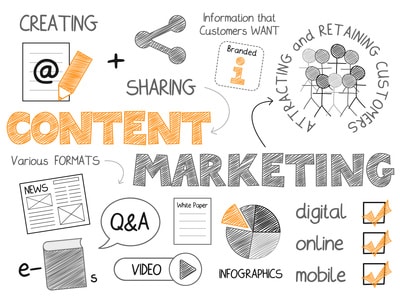
Although some people may think it’s sales or advertising, quality content is a major factor in developing an online business. -And, despite the fact that those same people may think quality content should be about the sale, developing content for SEO takes into account that people search to be informed, not sold.
Learning how to create content to inform and sell can be a frustrating endeavor, however. For both your company and your consumers to get the most of your content, it’s important to understand two powerful types of content and how to use them to your benefit: content marketing and custom content.
A Brief Comment on Content Creation
When the term content is used today it can refer to a variety of digital assets, but it usually refers to the written word. Everything your business uses to communicate with your audience is content: informational articles, newsletters, even traditional ads. Then again, so are those images you uploaded to your blog, or that video you downloaded from YouTube.
Every marketing effort uses content of some kind. It brings your audience directly to your brand. It’s the genteel approach.
Content for the Purpose of Content Marketing
Content creation for the purpose of content marketing is the most commonly talked about. In fact, a lot of resources and companies will lump content creation into this category indiscriminately. However, confusing all content to be “content marketing” can be a costly mistake.
All content is not created equal. Specific types are determined by the fundamental purpose of whatever content you want to create.
Using content in marketing attracts new potential customers. This kind of content focuses on driving cold traffic to your site. While return users can benefit from this experience, the ultimate goal is primarily reaching those unfamiliar with your site or brand. The idea is to target a problem and inform the reader to begin building a relationship. Think of this as the ‘getting to know you’ stage of your content.
For example, a newsletter signup page is generally used as content marketing. “Subscribe to get insights!” your call-to-action might say. This assumes that individuals don’t already get your insights.
Creating Custom Content
Custom content focuses specifically on your brand. It’s less valuable to fresh customers looking for general information. Instead, it targets those already familiar with your brand.
Think of the newsletter example above. If content marketing is a “subscribe to insights,” the custom content might be a newsletter just for clients. Other examples of custom content include such assets as follow-up product guidebooks and updates.
This is the content you will use to actually sell your product or service and build influence in your market. It goes beyond general information, focusing more on audience influence rather than audience attraction. Sales copy and promotions are easily inserted into these articles, encouraging loyalty built upon the trust developed through content marketing.
By this point, your audience expects you to have something of value to sell and will be more receptive to hearing about it. Consider this the ‘offering’ or selling phase.
Side-by-Side
Content marketing, if used as the sole method of communication, can end up alienating your customers. After all, most customers are no longer looking for general information once they have bought into the brand.
Remember that content marketing reaches out to find new traffic, not to generate sales. Articles, videos and other informative media can be linked together to funnel visitors to specific products or services. Custom content allows the visitor to control their experience with your company.
Your audience is pulled in by the urge for information about a problem, not necessarily to buy something. When they are ready to be buy, they will seek out specific information about products or services. Using content marketing, you can make that step easier for them without being intrusive. Using a two-step process instead of content marketing alone promotes customer engagement and satisfaction with your brand.
Writing the Content
Separating these different types of content extends to the writers as well. Agency writers make better content marketing articles by researching the topic rather than promoting your brand. The content is more likely to be informative and attractive to new visitors than if written by your in-house team.
For custom content, however, hiring a team of writers familiar with your brand and products ensures accurate and targeted information. Your writers know how to convert the traffic gained from marketing into sales and repeatable profits.
Final Thoughts
All content is created to attract traffic to your site. New traffic requires different strategies than repeat traffic, as they have different goals. Informative content feeds into sales content, creating a powerful chain in the sales cycle. Either content type alone won’t generate the same results or profits. Don’t just develop content; leverage your writers effectively and create a content brand.
